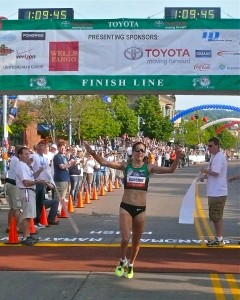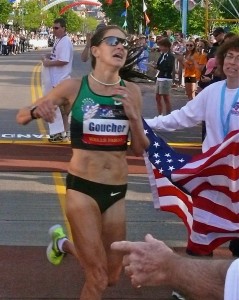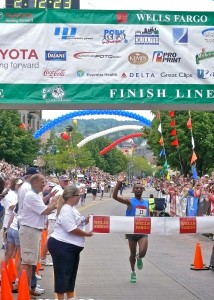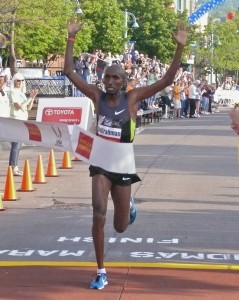Kara and Abdi — Americans win at Grandma’s

Kara Goucher stopped over on her way to the London Olympics to set the fastest time ever in the women's segment of the Garry Bjorklund Half-Marathon.
By John Gilbert
All 36 Grandma’s Marathons have been unique, even though the 26.2-mile run down Hwy. 61 from Two Harbors to Duluth’s Canal Park has taken on an air of similarity in recent years, to the point where cynics say “Which Kenyan will win this year?” Usually a couple of Ethiopian runners challenge the dominant Kenyans, but without question, the East Africans have taken over the race.
This year, of course, we had the gratifying experience of having Kara Goucher, the hometown Olympic hero, make her first running return since she ran for Duluth East High School. The training regimen for those elite runners who will compete in the Summer Olympics in England in a few weeks calls for specialization of distances as they work up to the Olympic marathon. Timing called for Goucher to run a half-marathon right about now, so Grandma’s, with its accompanying Garry Bjorklund Half-Marathon, was the perfect setting.
On top of that, Grandma’s was designated as the USA Half-Marathon Championship this year, which was even more incentive for Goucher, who came through to win in 1 hour, 9 minutes, 46 seconds — the fastest any woman had ever run Grandma’s half-marathon course. The previous record was a 1:10:00, by Colleen De Reuck of Boulder, Colo., in 2003, also during a USA Women’s Half-Marathon championship.
Goucher’s 1:09:46 was the second-best of all-time to Shalene Flanagan in a USA Women’s Championship, five seconds behind the record set by Flanagan at 1:09:41 in the 2009 USA event in Houston. It was Flanagan who beat Desiree Davila and Goucher in the Olympic Marathon trials, when all three qualified for the U.S. team. Flanagan is Goucher’s training partner in Portland, Ore., where Goucher lives with her husband, Adam, and son, Colt, 2.

Kara Goucher pulled away to win the half-marathon, then was directed to some television interviews by race director Scott Keenan.
When Goucher finished, she had the perfect line: “I’m going to Bridgeman’s,” she said, referring to Duluth’s ice cream restaurant, which was a regional chain that she loved growing up. Never mind Disneyworld; she wanted a chocolate milkshake.
A day before the marathon, Goucher said, “I’d love to wave to my parents, and grandparents, and all my friends along the route, but I’m not going to. I’m going to wear sunglasses and focus in. I’m here for a reason. I’m super-nervous because there’s a lot of pressure to not mess up.”
Messing up was never in the picture. She admits she had let herself get out of elite running shape last summer. She switched coaches, from former Olympic star Alberto Salazar to Jerry Schumacher, and she has worked long and hard to get herself back up to her standard of competitive readiness. She knows her best days are ahead.
“I’m nowhere near the peak of my career,” Goucher said.  “I feel like London might well be my best, and maybe the first of what will be my four or five best marathons.”
“I feel like London might well be my best, and maybe the first of what will be my four or five best marathons.”
The next day, she ran brilliantly, outdistancing Maegan Krifchin, 24, of Dewitt, N.Y. Krifchin was a compelling story herself; she ran her personal best of 1:10:44 in only her second try at the half-marathon distance. “This was a great experience for me,” said Dewitt. “I was third at Jacksonville in my only other half-marathon [at 1:11:04], and this has been my focus ever since.”
Goucher said she had to concentrate to avoid being overwhelmed emotionally during the race. “This was very personal for me,” she said. “I couldn’t have asked for anything more. It was amazing to see all these people along the way, cheering me on. I had to shut down my emotions. With two miles to go, I literally had goosebumps. I wish I could go back and talk to everybody that I saw along the way.”
In a way, the 2012 Grandma’s was the high school reunion she had missed because of a running conflict. “As a kid, I handed out water to runners in Grandma’s, and I’d run at Park Point,” Goucher recalled.
“When I was young, I worked right over there, at Grandma’s Marketplace,” she said, gesturing across the parking lot from the finish line. “I used to go rollerblading on the boardwalk with my friends, but I thought the people who ran the marathon were crazy. When I was in high school, the half-marathon started, and I thought those people were crazy, too. When I ran track, I never thought of myself as anything more than a miler, or maybe a two-miler.”
And now, after running the 5000 and 10,000 meter runs in the 2008 Olympics, Kara Goucher is not only running marathons but is rising to a personal peak that might crest while going for marathon gold in the Summer Olympics in London. Duluth may well see her again.
Is there a chance she might return to run Grandma’s next summer? “Absolutely,” she said. “If I win the Olympics, I’ll be back here. This would fit perfectly if I run the marathon in the World Championships next year.”
THE FULL MARATHON
Young American runners who got started when their parents drove them to a park so they could run around the track might have trouble accepting, or even understanding, the way of life in East Africa, which spawns so many blade-thin runners that can dominate all the elite spots in U.S. marathons. Normally, the runners from Kenya run away from everybody else. Not this time.
Berhanu Girma defeated Ethiopian countryman Chala Lemi to win this year’s Grandma’s Marathon — the first time an Ethiopian ever won at Grandma’s. Everlyne Lagat of Kenya won the women’s division. Girma’s winning time of 2:12:25 wasn’t among the top 10 all-time Grandma’s records, but it was 33 seconds ahead of Lemi.
Girmo ran amid a group of seven runners for most of the first half of the 26.2-mile distance before he and 2008 Grandma’s winner Lamech Mokono of Kenya pulled ahead. But on this day, the usually dominant Kenyans were upstaged by the pair of 25-year-olds from Ethiopia, both of whom benefitted from growing up running the mountainous terrain of their homeland as a matter of necessity; a way of life. That was good training when the leaders got to the abrupt rise of Lemon Drop Hill, at 27th Avenue West and London Road, and the biggest hill on the course — named for a former restaurant that was located at the top of the rise, but has long since disappeared.
It was there that Girma made his move to leave Mokono behind. “When we went up the steep hill, I got away from the Kenyan,” said Girma. “After the steep hill, no one challenged me.”
At the same Lemon Drop Hill, Lemi made his move. “Before that hill, I was sixth,” said Lemi. “I passed five other runners at the hill.”
Girma was far enough ahead that he was unaware of Girma’s pursuit, and his 2:12:25 was 33 seconds ahead of Lemi’s 2:12:58, while Mokono took third at 2:13:28.
Both Girma and Lemi list Addis Ababa as their home in Ethiopia, but both grew up in smaller villages in the mountainous regions nearby. Both runners’ childhoods give a glimpse into what makes East African runners so superior.
“This is my first time in Duluth, and the only other marathon I ran in the U.S. was the Twin Cities Marathon last October,” said Girma, who didn’t run formally until he joined a club after moving to Addis Ababa. “I grew up in Arsi, a small village with high elevation, and my mother lived in another village, about three hours away, walking. I would run it in an hour and 10 minutes. I would run on normal roads, but there were shortcuts through the fields.”
Lemi said he was from Entoto, a small, high-altitude village. “I used to run to school when I was growing up,” he said. “It was about a two-hour run. Sometimes I would run eight hours in a day.”
No cars, no rides, not always roads. If young men and women in East Africa need to get somewhere, they walk, and more likely run. Not always, however.
Lagat won the women’s full marathon in her third try at Grandma’s. She was third in the 2010 Grandma’s, second last year, and won it this time, clocked at 2:33:14, while Mulu Seboka, another Ethiopian, was a distant second, at 2:34:54. Lagat was in a lead pack of five runners for the first part of the marathon, but pulled ahead and got away from the field despite stomach cramps and an aching hamstring.
“I didn’t think about the pain preventing me from finishing,” said Lagat, 31, who came from Kenya seven years ago to train in New Mexico. “If you think about something like that, it can cause you to stop. Then, near the end, I knew if I could stand the pain for one more mile, I could win.”
Sebaka grew up in the village of Mulo, in the Ethiopian mountains, but at age 27, she is still a novice runner, with a promising future. “I didn’t run as a kid,” she said, through an interpreter. “I didn’t run until we moved to Addis Ababa. One of my friends said I should go to a club and try running, when I was 19 or 20. My first marathon was three years ago in Addis Ababa, and I was fifth. I’ve run a total of nine or 10 marathons, and this was my third in the U.S., but it was not one of my best. I’ve run 2:25 before.”
TRANSPLANTED OLYMPIAN
At first, I flinched when I saw the name Abdi Abdirahman as a U.S. Olympic marathoner, who was coming to Grandma’s to run the half marathon as conditioning, much like Goucher. I have no quarrel with naturalized citizens moving to the U.S. and becoming citizens, but it seems unfair when they make the U.S. Olympic team, leaving behind U.S.-grown and trained athletes.
But after Abdirahman won the men’s portion of the USA Half-Marathon championship, I learned that he is more than just deserving of a spot on the U.S. team. Abdirahman ran the fourth-fastest Grandma’s half-marathon of 1:02:47, winning narrowly over Brett Gotcher, of Flagstaff, Ariz., who was only three seconds back, at 1:02:50, and Ian Burrell, of Tucson, Ariz., who clocked 1:02:51.
“I wasn’t surprised at how competitive it was,” said Abdirahman, 35, who lives in Tucson, Ariz. “I have respect for the great runners I was running against. Nothing was guaranteed, but at the same time, I felt confident. With a mile to go, I started making my move.”
Gotcher said he was amused that some fans cheered “Go, Adam,” to him, mistaking him for Kara Goucher’s husband because of the similarity of their last names. When it was relayed that Abdirahman said he had made a final surge, Gotcher said, “He was surging the whole race. I tried to stay with him, but in the last 250 meters, I couldn’t do it.”
Here is the reason that Abdirahman completely overturned my feeling about athletes who come to the U.S. and get naturalized to compete for the U.S. in the Olympics. “We came as refugees in 1989,” he said. “I was 7, and I had two brothers and two sisters, and another sister was born here. I was born there, but I’ve never been back to Africa since I left.”
While he looks much like the sterotypical East African runners, with shiny black skin and a razor-thin body, Abdirahman has picked up a few phrases growing up in the U.S. Someone asked if he was satisfied with his time. “I’m satisfied,” he said. “Is there a time adjustment for humidity?”
Someone asked about his training regimen. “I’m in the middle of heavy training right now,” he said. “This is perfect for my training. From now on, I’ll run longer distances. It’s not rocket science — if I feel good, I’ll run; if I don’t, I won’t. This is not like basketball; I don’t have to set a pick.”
A reporter unconcerned with political correctness heard Abdirahman tell me he was from Somalia. “You’re Somalian?” the reporter said. “You look Ethiopian.”
Abdirahman didn’t flinch, but he shot a glance at me , and with a subtle grin, said: “Ethiopian? They all look the same to me.”
Comments
4 Comments on Kara and Abdi — Americans win at Grandma’s
-
Do Not Hesitate To Purchase Classic Nike Free 2.0 Yellow on
Wed, 18th Mar 2015 5:56 pm
-
Cheap Nike Free XT Womens on
Wed, 18th Mar 2015 6:07 pm
-
Nike Free TR FIT 2 Womens Can Make You Run Faster on
Thu, 19th Mar 2015 10:38 pm
-
Quest Bars on
Thu, 18th Feb 2016 8:58 pm
This design is wicked! You definitely know how to keep a reader entertained. Between your wit and your videos, I was almost moved to start my own blog (well, almost…HaHa!) Fantastic job. I really enjoyed what you had to say, and more than that, how you presented it. Too cool!
(Glad you enjoyed it…JG)
Thanks for your personal marvelous posting! I certainly enjoyed reading it, you might be a great author.I will make certain to bookmark your blog and will eventually come back down the road. I want to encourage you to ultimately continue your great writing, have a nice afternoon!
(Thank you…JG)
Appreciating the dedication you put into your site and detailed information you offer. It’s good to come across a blog every once in a while that isn’t the same out of date rehashed material. Fantastic read! I’ve bookmarked your site and I’m adding your RSS feeds to my Google account.
Just wish to say your article is as astonishing. The clearness on your put up is simply nice and that i could think you’re a professional on this subject. Well together with your permission allow me to
take hold of your RSS feed to stay updated with imminent post.
Thanks 1,000,000 and please continue the enjoyable work.
Tell me what you're thinking...
and oh, if you want a pic to show with your comment, go get a gravatar!





 John Gilbert is a lifetime Minnesotan and career journalist, specializing in cars and sports during and since spending 30 years at the Minneapolis Tribune, now the Star Tribune. More recently, he has continued translating the high-tech world of autos and sharing his passionate insights as a freelance writer/photographer/broadcaster. A member of the prestigious North American Car and Truck of the Year jury since 1993. John can be heard Monday-Friday from 9-11am on 610 KDAL(www.kdal610.com) on the "John Gilbert Show," and writes a column in the Duluth Reader.
John Gilbert is a lifetime Minnesotan and career journalist, specializing in cars and sports during and since spending 30 years at the Minneapolis Tribune, now the Star Tribune. More recently, he has continued translating the high-tech world of autos and sharing his passionate insights as a freelance writer/photographer/broadcaster. A member of the prestigious North American Car and Truck of the Year jury since 1993. John can be heard Monday-Friday from 9-11am on 610 KDAL(www.kdal610.com) on the "John Gilbert Show," and writes a column in the Duluth Reader.